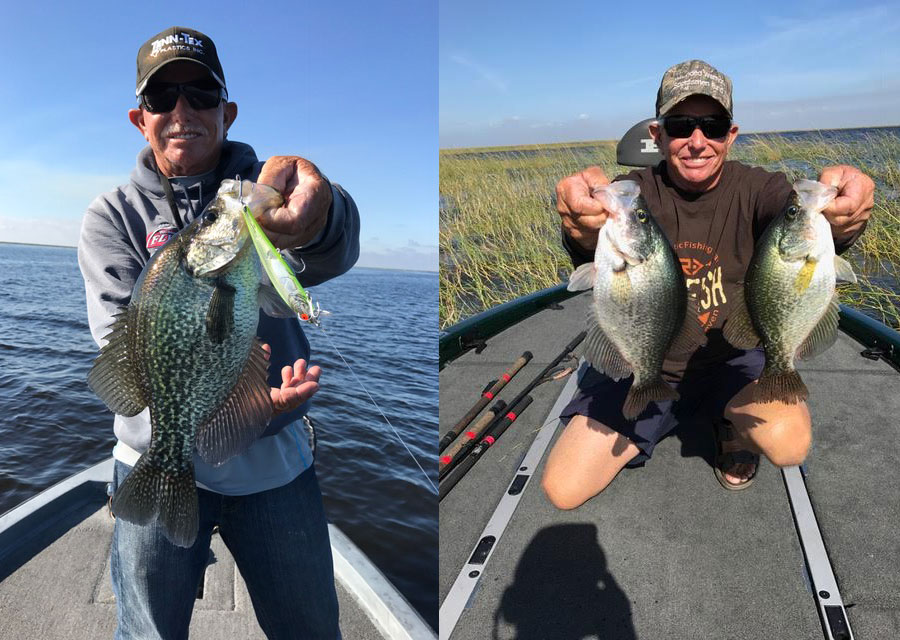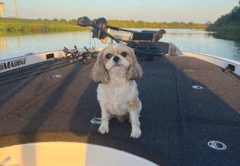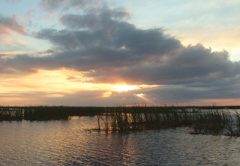
The start of the 2017 calendar year is still fresh and already the 2017 Speckled Perch Season is making headlines. Two weeks into the New Year and reports are coming in from Lake Okeechobee and Highlands County of large 2 to 2.5 lb slabs being boated on a regular basis.
Next to largemouth bass, Speckled Perch (Specks), also known as Black Crappie, are Florida’s second most sought after freshwater game fish. With northern lakes frozen during this time of year, legions of Crappie fishermen make their annual pilgrimage to central Florida lakes for these feisty yet tasteful panfish.
Whether it’s the receding high water from last year’s El Nino event, or the arrival of the first cold fronts of the 2017 winter season, Specks summering in the open waters of Lake Okeechobee are showing up along the shorelines and they are big and aggressive. Specks are known to be fickle eaters but this year some of the bigger Specks are taking large artificial lures that are typically used by bass fishermen as experienced by Captain Steve Daniel catching Specks on a Bomber Long A jerk bait in the Harney Pond area of Lake Okeechobee.
Speck fishing on area lakes is a year round activity. During the summer months Specks usually spend most of their time in the deeper, open waters of the lake chasing schooling baitfish. During this time the best way to catch Specks is to use your electronic fish finders and troll known Crappie hang-outs in search of schools of bait fish. Once you locate the baitfish, drop a buoy to mark your location and then drop and anchor or drift the area with minnow-tipped jigs to target the Specks feeding on the school of baitfish. Here the use of spider rigs will greatly aid in pin pointing the location of the Specks. The technique of spider-rigging is the deployment of multiple rods set around your boat to cover the maximum amount of surface area your boat drifts through. To further improve its effectiveness, use a variety of colored jigs set at different depths to zero in on where the Specks are feeding and what color they fancy that day. Specks are notorious for being color selective and a hot color today may not buy you a bite tomorrow. Drift or reset you anchor as the baitfish move and if the bite stops, pick up and move to another location to acquire another school.
Depending on the weather, starting in November, open water Specks will begin to migrate to just outside the grassy shoreline and begin their pre-spawn period. Here you’ll find them holding in channels, structured points and the deeper submerged grasses. Like most fish, the pre-spawn period is a time to bulk up and store the energy needed for the spawn. During the pre-spawn the Specks are extra sensitive to the weather patterns. Falling barometers and dropping water temperatures from strong cold fronts will drive them back offshore but only to return when conditions moderate. During this period, locating the depth at which the Crappie are feeding is vital. Here again the deployment of spider rigs will aid in the location and feeding pattern of the Specks. Being in shallower water also opens up your fishing options. Don’t be afraid to use ultra-light tackle and artificial lures such as; small minnow like black and silver Rapalas, inline spinners, beetle spins, Colorado bladed spinners and curly tailed grubs. Besides being able to cover a lot of water, catching a feisty Crappie on 4-lb test ultra-light is just fun.
Just be mindful of their membrane tissue mouths, they are soft and tear easily so don’t horse the fish and have a landing net at the ready. They are called ‘paper-mouths’ for a reason.
Starting in mid-January through March, Specks begin to move into the grasses and bulrushes to spawn. The period around the full moon will be the best time of the month for the full moon drives the females to the beds. This makes the days immediately after the full moon a great time to catch your limit. Crappie are free spawners, that is they prefer not to make tradition beds.
The females lay their eggs in and around grass and on top of the roots of floating leafed plants such as lilies and spatterdock. The male follows up after the female to fertilize the eggs after which the female departs the site while the male remains behind to protect the brood. Generally the females will leave the spawning area and return to pre-spawning sites while males will patrol the nesting areas. Those males remaining behind are generally not in a feeding mood. They are there to protect the eggs from predators so they will be looking to kill or wound predatory baitfish. This makes their initial strike a strong fierce bite so you’ll need to be ready to set the hook, otherwise Poppa Crappie will spit out what he thinks he’s killed and going looking for another enemy of the nest.
Fishing the grasses and lilies for Specks requires stealth. Approach these areas slowly and the use of extra-long Crappie poles will come in handy. If you can, stay outside the edges and reach out with the extra length of your rod and drop your jig and-or minnow into the open areas. Whether you use a float or free line the offering is up to you but the float will enable you to preset your depth so your bait is not lying on the bottom. If you don’t get an immediate bite, slowly jig your line to attract a little more attention. After a few minutes without a bite, pick up you bait and move it to the next opening. Also keep in mind that there are Specks, probably males, still patrolling the outside edges of the grass so make sure you cover these areas as well. Specks like to feed on insects, so those areas infested with flying insects are prime Speck areas. Just arm yourself with bug spray and mosquito netted hats to prevent yourself from become the bait. Be sure to wash your hands thoroughly after the application of any bug sprays and sunscreens.
There has been a lot said about the fickle nature in which Specks feed. You talk to one angler on the north end of the lake and he’ll tell you they are taking peanut butter and jelly colored jigs while just a few miles away they are taking jigs with chartreuse heads and white bodies. The best way to cover your bases is to have a plastic organizer filled with a wide selection of local colors and weights. Conditions change on the lake and having a diverse selection of jigs will help you match the water and feeding conditions. The only way to prepare yourself for matching the hatch is to visit a variety of local bait and tackle shops and ask. Find a shop tying their own Crappie jigs and you’ll be golden.
Winter Speck fishing in central Florida can be fast and furious. There is no better time to introduce a young child to the sport of fishing then when there is plenty of action and you’ll be rewarded with a bunch of laughter, smiles, and a stringer of tasty fish. The kid will have fun too so take the time and take a kid fishing.






